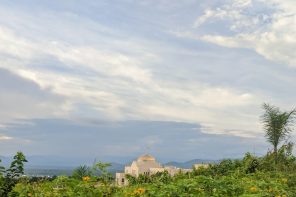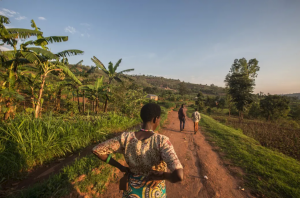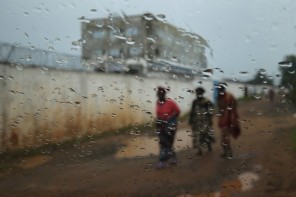Not that kind. Not the Gospel, and not heartwarming features about an NGO or a noble American doing good and fixing Africa. I mean news, well done, from Africa.
I just published an essay with the Boston Review about the Africa/suffering story paradigm. I wrote it becasue I wanted to try and understand why our dominant narratives from Africa are stories of suffering, and why the centripetal force of the industry in which I work seems to hold us there. Those questions require more than even the couple thousand words I strung together over there, but the argument itself also needs something more: A look at some good news from Africa, and why it is so good.
This is different than “good news about Africa.” The positive-stories agenda is not mine; it can have the same weaknesses I try to think through in my essay. “How far Africa has come” stories still use suffering, poverty and our other least-favorite cliches as their baseline. Besides that, stories about violence and conflict in Africa can be extraordinarily well done, and stories about “good news” in Africa can be sloppy and irresponsible. It isn’t the topic that defines the kind of good news I’m interested in; it’s the quality of the journalism.
So I’ve chosen a few of my favorite pieces. Like any piece of writing, none of them is perfect, or complete. But they are imperfect and incomplete in an unusual way: they point to worlds bigger than themselves, and they make me think of other stories I want to hear, other things I want to know. They remind me that ‘complete’ is the work of a lifetime of attentive reading and listening and dialogue (and, for some of us, writing). They don’t leave me thinking I understand a place, or that the place is all suffering.
So here’s some work I like. I hope you’ll share work you like, too.
“Long Run to Freedom” and “The Mysterious Death of Sammy Wanjiru,” by Anna Clark, Grantland. Clark’s investigation of Wanjiru’s death is a masterfully written narrative (one so good the New Yorker ripped it off nearly a year later. Note to the New Yorker: It’s cheaper and faster just to hire Clark). One of my favorite parts, though, isn’t about Wanjiru or the possible-murder mystery. It’s about Kenya:
In Kenya, there are many runners and few joggers.1 In the West, it’s the other way around — few elites are distinguished from the middle-class masses that lace up for weight loss, hometown 5Ks, or runs down country roads with the family dog setting the pace. While fitness culture is broadly marketed in the West, Kenyans run in competitions and in training camps. Hobbyists are hardly trotting along Nairobi’s hectic streets.
One tiny little paragraph, so much locally rooted insight. And that rarest of generosities: a nod, via footnote, to the earlier writer who really got at the idea. (Note to the New Yorker: That’s also an option.)
In included “Long Run to Freedom” because it does the opposite of what so many stories do: It takes the Olympics and makes them about Africa (or rather, one country there), instead of taking Africa and making it into a story about… pretty much anything else.
“In Africa, a new middle-income consumerism,” by Stephanie McCrummen, Washington Post. Four years ago, when many of us were still grinding out “grinding poverty” stories, McCrummen was writing about the middle class in Kampala. One thing I love about this story is how her lead subject, Denis Ruharo, is in on the joke of the American approach to middle-class credentials. He dives right in and offers her a list of things that show his status (“What else” is one of my favorite quotes, ever):
“I have the mortgage and home improvement,” he said, glancing at the budget he and his wife keep on their computer. “The car, carwash and parking tickets. Entertainment — cable TV, two movies a month. The health club. Then normally we vacation twice a year. Last time it was Nairobi.”
“What else,” he said, scrolling down on his Mac PowerBook. “Newspapers, charity, clothes, books and CDs . . . “
The trend isn’t just about materialism. As she writes, it’s “more than the availability of Chilean wines and red patent leather pumps from Paris. It reflects a gradual opening up of African economies, a freer flow of information and a parallel rise in expectations, some political.” But what a deft way to hint to readers, “Hey, there’s South American wine and European shoes and the same MacBook you have… all in Africa.”
“Machete,” by Jennifer Gonnerman, New York magazine. A refugee from Sierra Leone’s civil war escapes, only to find violence in America. Suffering is inescapably part of this story, but Gonnerman writes about real people, not sources-as-symptoms-of-violence, and she bases her story on an arc of their experiences, not a single moment of violence.
“Water Delivery Man Has Fans in Parched Nairobi,” by Gwen Thompkins, NPR. Thompkins is a genius at admitting the ordinary into her story, and if you really want a study in well-done journalism from Africa by foreigners, you should spend a day listening to the work she produced while she was NPR’s East Africa correspondent. I picked this story because it turns out that selling water in Nairobi is really boring. The story is that there isn’t water, and a guy has a truck, turns it on, and sells people water. That’s it.
But Thompkins makes it so much more, and allows so many normal-life things in Africa — drought, yes, and waiting to collect water, being between jobs, a ubiquitous pan-African optimism — to pop. And if you’re not sure whether it’s Thompkins, read the transcript: The quotes she gets are dead on the page. But Thompkins turns them into a lovely portrait with terrific ambient sound and with fast-paced, playfully rendered context, and all I want to do is meet this guy with a water truck. (Note to self: No good blaming bad quotes for turning in a boring story.)
“The Invisible Country,” by Tristan McConnell, Virginia Quarterly Review. McConnell turns the cliches he suspects we hold about conflict-ridden Africa against us, writing away from them to open up our understanding of Somaliland, a quasi-independent part of Somalia. “I walked the hot sandblasted streets, bought ripe fruits from roadsides talls, sat beneath shady trees to drink camel milk tea and chat with locals, many of whom spoke English with an American twang….It certainly didn’t look like a breakaway region from a failed state.” It would be easy to write a story about the delightful curiosity that is a semi-functioning part of what list-icle wisdom tells us is the least functional country on the planet. That’s not what McConnell does. He bends our curiosity into a closer look at Somaliland and what makes it work:
“We tried a multiparty system in the 1960s and instead of political parties we had tribal groups. They used to mushroom before the elections then die after them. Instead we have three institutionalised political parties taht will last. So because of our traditions we have to have limitations to prevent parties purely based on tribe or region,” [one senior politician told McConnell. McConnell continues:] This is pragmatism, but is it democracy? Pehraps not as teh West might recognize, but for Somaliland this limited democracy is working because it is rooted in the local context.”
(Don’t worry, Somaliland-watchers: He gets to all the delayed election business, etc. etc.)
“In Zimbabwe Land Takeover, a Golden Lining,” by Lydia Polgreen, New York Times. I’ve long been a mega-fan of Lydia Polgreen’s work — most of what she writes about she writes does better than anyone — but I highlight this piece because it dares to ask us to hold two ideas in our head at once:
Before Zimbabwe’s government began the violent and chaotic seizure of white-owned farms in 2000, fewer than 2,000 farmers were growing tobacco, the country’s most lucrative crop, and most were white. Today, 60,000 farmers grow tobacco here, the vast majority of them black and many of them working small plots that were allotted to them in the land upheavals. Most had no tobacco farming experience yet managed to produce a hefty crop, rebounding from a low of 105 million pounds in 2008 to more than 330 million pounds this year.
The success of these small-scale farmers has led some experts to reassess the legacy of Zimbabwe’s forced land redistribution, even as they condemn its violence and destruction. (Bold by Jina)
Judging from the Internet, Polgreen took some flack for this piece. The criticism seemed to center on what she didn’t write, some of it seeming to me pretty far afield from the story. For me, the criticism echoed the refrain with which readers often unfairly burden journalists (foreign especially) writing about Africa: “You didn’t tell my truth.” Often, the unstated implication is that “my truth” is the “real” truth. Polgreen’s piece revealed a different narrative (“a new truth” would e overdoing it) and asked us to consider that in tandem with the narratives we already know about Zimbabwe generally and land redistribution specifically. I think that’s the kind of journalism we should be doing, and I appreciate that she respects readers enough to do it.
“A Dying Breed” and “Is There Such a Thing as Agro-Imperialism?,” by Andrew Rice, New York Times Magazine. Rice is the best of the journo bunch tackling sweeping Africa stories. His article on land grabs in Africa, the first broad treatment I remember reading in the mainstream media, is obviously a sweeping story, anchored to real places and people through well-chosen details. You wouldn’t think that Ankole cattle of Uganda are similarly sweeping — which is one of many surprises in this fantastic piece about humanity’s long experience with herding — “Every cow in the world is the product of some human agency” — and the (so-framed) battle between culture and commercialism in Uganda’s cattle industry. Or, as a Land O’Lakes representative put it, ““Culture — fine, it’s good to have. But first, the stomachs.”
I’m just getting started. Check back for more. And please, leave in the comments or send me by email foreign reporters’ stories from Africa that you think work well.




good piece, I ate my heart out… wonderfully portrays the lies told about Africa in a nutshell as nothing more than a lie, only to make Africa look bad when everything that makes the other side beautiful comes from right here, should I say this is another “don’t bite the hand that feeds you” in a different picture? thanks…
It’s far too late; your unbiased reputation is shot full of holes. What’s needed is not for the same ones to tell a different story, but an entirely new set of story-tellers who can relate to the story being told.
in most case, the message is not for the messenger, he/she can only be a bearer…
Even more than in written form, the problem has been the images coming from Africa, in the news but also the NGOs, and that’s the irony, having to wreck the image of the continent in order to raise money to “help” it!
Some have started re-balancing the “deficit of image” but this is a huge task considering the amount of visual negativity that has been produced over the past decades.
http://www.facebook.com/theotherafrica
“Habari dada Moore, nadhani tatizo kuhusu habari, hadithi, na disturi za waafrika inatokana na wale wanayo andika na wanayo jaribu kueleza hizo habari. Mara nyingi sauti za waafrika hazipo kwenye majadiliano. Tangu siku za mwanzo, kuna waafrika ambayo wako tayari kusumulia habari, hadithi, na disturi zetu. Je, wageni kutoka nje wako tayari kutusikiliza? Ninahisi jibu litakua hapana!!”
Basic translation:
Greetings sister Moore, I think the problem regarding news, stories, collective history of Africans stems from those who often write about, or try to explain, those news stories. In many instances the voice of Africans themselves is missing from the discourse. Since the earliest days, there have been Africans who are ready to convey our stories, experiences, and collective histories. Are outside guests (i.e. foreigners) ready to truly listen to us? Regretfully, I think the answer is no!!
Additional thoughts: I think too few western journalists/academics/politicians/development specialists/aid-workers engage in discussions that Africans have with each other. Western activists often discuss African issues amongst themselves. The Eurocentric narrative of Africa has been, dare I say…”warped”, ever since the earliest encounters by da Gama, Gomes, Speke, Stanley, Pinto, Rhodes, Carter, Leopold II, et al. Unfortunately the narrative has essentially matured little since then.
Many westerners still regard Africa as a “country” (rather than a continent of varied peoples, cultures, languages, histories, experiences), and see it as a troubled and hopeless place characterized by poverty, tribal war, rape, hunger, misery, refugees, child soldiers — in desperate need of rescuing/saving by caring outsiders. How else to explain the online viral response to Invisible Children’s KONY 2012 campaign?
Regretfully I don’t expect the skewed perspective/lens on Africa to ever change in the minds of westerners?!!
true…. Heri Muhero, you got a point plus! good insight!! lets write our own story…